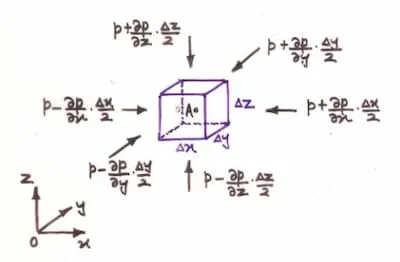At a point,
P=δA→0limδAδF
The hydrostatic pressure at a point is the same from all directions.
Consider the fluid element shown, containing the point A.
From the image:
sinθ=ΔsΔz∧cosθ=ΔsΔx
For equilibrium:
Px(ΔyΔz)−Ps(ΔyΔs)sinθ=0⟹Px=Ps
Pz(ΔxΔy)−Ps(ΔyΔs)cosθ−21ΔxΔyΔzρg=0⟹Pz=Ps+21Δzρg
As all Δx,Δy,Δz approaches 0: Pz=Ps. Therefore
Px=Pz=Ps
Let p be the pressure at the point A≡(x,y,z).
p=f(x,y,z)
dp=∂x∂pdx+∂y∂pdy+∂z∂pdz
By considering equilibrium of this fluid element containing A.

In the x direction,
(p−∂x∂p2Δx)ΔyΔz−(p+∂x∂p2Δx)ΔyΔz=0
∂x∂p=0
Similarly ∂y∂p=0 can be proven.
In the z direction,
(p−∂z∂p2Δz)ΔxΔy−(p+∂z∂p2Δz)ΔxΔy−ΔxΔyΔzρg=0
∂z∂p=−ρg
dp=−ρgdz
p=−∫ρgdz
Surface of constant pressure.
Pressure exerted by atmospheric air.
Measured in respect to atmospheric pressure.
Measured in respect to perfect vaccum.
Absolute Pressure=Atmospheric Pressure+Guage Pressure
P=−ρgz+c
P+ρgz=c=P∗
A diagram showing the variation of pressure along a submerged surface.
Height of a particular fluid column that will produce the pressure at a point.
Pressure head=h=γp
Suppose there are 2 points A,B with a height difference of h.
P1=−ρgz1+c
P2=−ρgz2+c
P2−P1=−ρg(z2−z1)=−ρg(−h)=hρg
P2=P1+hρg
